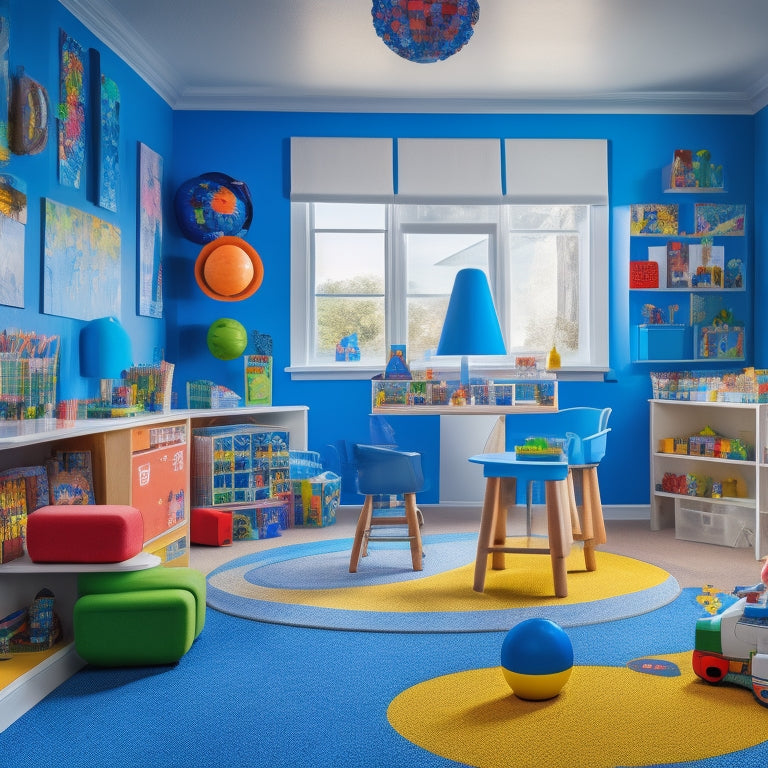
Exciting Educational Toys Unveiled for Kids
Share
This year's exciting educational toys for kids are designed to inspire creativity, foster imagination, and build essential skills through interactive play, making learning a fun and engaging experience. These innovative toys promote hands-on exploration, problem-solving, and sensory experiences, which are essential for cognitive development. From building blocks to painting house toys, these educational wonders spark creativity, critical thinking, and curiosity, refining information processing abilities and motor skills. By tapping into the power of play, kids can adapt to new situations, develop a love for learning, and reveal their full potential - and there's more to discover in the world of educational toys.
Key Takeaways
• Interactive educational toys facilitate hands-on exploration, promoting cognitive development and problem-solving skills in kids.
• Imagination-driven toys like Water Drawing Mats and Balance Puzzles inspire creativity, innovation, and artistic expression.
• Sensory-rich toys like playdough and painting house toys stimulate motor skills, information processing, and adaptability in children.
• Engaging with educational toys cultivates creativity, curiosity, and a love for learning, essential for lifelong development.
• Play-based learning experiences with educational toys build essential skills, including critical thinking, and help kids think outside the box.
Unwrapping the Fun of Learning
By carefully selecting educational toys, children can begin a fun-filled journey of learning, where playtime seamlessly merges with cognitive development. Interactive playtime and hands-on exploration are essential components of this process, allowing kids to engage with their surroundings and absorb valuable knowledge.
Toys that facilitate interactive playtime, such as building blocks and puzzles, encourage problem-solving and critical thinking. Hands-on exploration is also fostered through toys that promote sensory experiences, like playdough and art supplies.
Toys That Foster Imagination
Imagination, a vital component of childhood development, is skillfully nurtured through a diverse range of educational toys that inspire creativity, innovation, and self-expression. These toys empower kids to engage in imagination exploration, participating in creative play that fosters critical thinking and problem-solving skills.
By entering a fantasy world of pretend adventures, children develop their ability to think outside the box, experiment with new ideas, and express themselves confidently. Toys like Water Drawing Mats, Magic Scratch Paper, and Drawing of Toy encourage artistic expression, while others like Balance Puzzle and Geometry Toys promote imagination-driven problem-solving.
These educational toys provide a platform for kids to ignite their creativity, building a strong foundation for future success.
Building Skills Through Play
Through interactive and engaging play experiences, children develop a range of essential skills that lay the foundation for future academic success and personal growth.
Building skills through play is vital for cognitive development, as it enhances problem-solving skills, critical thinking, and analytical abilities.
Sensory exploration, a key aspect of play, stimulates motor skills, hand-eye coordination, and fine motor dexterity.
As children engage with educational toys, they refine their ability to process information, make connections, and adapt to new situations.
Sparking Creativity and Curiosity
As children engage in play-based learning, they not only build skills but also cultivate a sense of creativity and curiosity that propels them to explore, experiment, and learn. Sparking creativity and curiosity is essential for children to develop a love for learning and become lifelong learners.
Educational toys that encourage creative exploration, such as painting house toys, magnetic books, and drawing mats, provide an outlet for children to express themselves and think outside the box. These curiosity boosters help children develop problem-solving skills, critical thinking, and imagination, setting them up for future success.
Frequently Asked Questions
Can These Educational Toys Be Used by Children With Special Needs?
"As we bridge the gap between ability and access, we ask: can educational toys be inclusive for children with special needs? Indeed, many toys incorporate Inclusive Design and Adaptive Learning, catering to diverse needs and fostering a more equitable play experience."
Are the Materials Used in These Toys Eco-Friendly and Sustainable?
When considering eco-friendly alternatives, manufacturers prioritize sustainable sourcing of materials, ensuring a reduced environmental footprint. Premium materials like ABS, high-quality wood, and non-toxic substances are carefully selected to minimize harm and promote a greener future.
How Do I Choose the Right Educational Toy for My Child's Age?
When selecting an educational toy, consider your child's learning style and age appropriateness. Identify their strengths, interests, and developmental needs, then choose a toy that aligns with these factors to guarantee an engaging and effective learning experience.
Can These Toys Be Used in a Classroom or Group Setting?
In a classroom or group setting, these educational toys can foster Cooperative Learning and positive Group Dynamics, encouraging collaboration, communication, and problem-solving skills, while promoting a engaging and interactive learning experience.
Are There Any Certification or Awards Received by These Educational Toys?
"Actions speak louder than words." Indeed, these educational toys have earned industry recognition, boasting certifications from reputable organizations, and garnered glowing parent testimonials, solidifying their credibility and effectiveness in fostering learning and development.